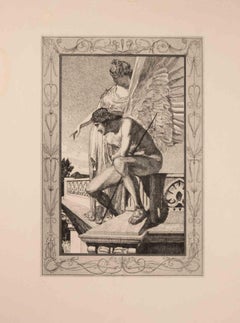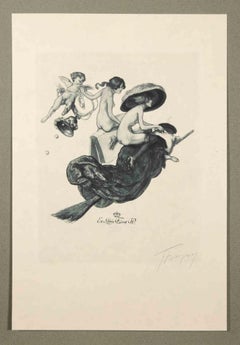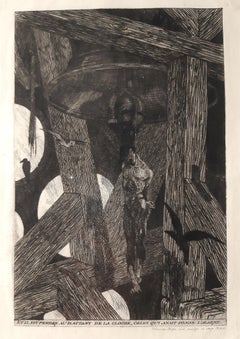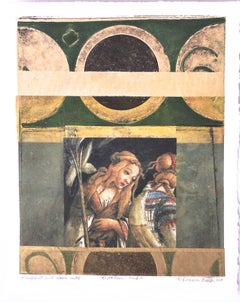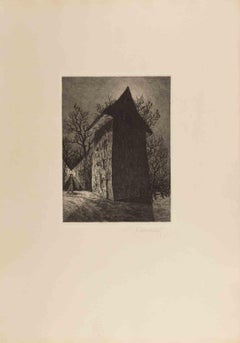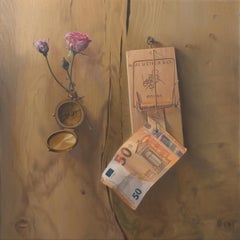Symbolist Art
to
103
572
103
158
44
74
Overall Width
to
Overall Height
to
2
108
640
204
27
103
111
93
13
12
24
18
49
15
114,459
65,100
54,891
27,102
14,944
9,352
6,534
5,786
4,192
3,055
2,593
2,327
2,253
721
604
264
65
566
355
233
182
181
109
101
58
48
48
46
38
33
31
26
25
20
20
20
19
258
224
161
159
134
95
44
38
37
34
132
433
547
248
Style: Symbolist
Venus zeigt Amor Psyche - Etching by Max Klinger - 1880
By Max Klinger
Located in Roma, IT
Etching and aquatint realized in 1880, belonging to the Series "Amor und Psyche", Opus V.
Ref. Singer 67, IV.
Excellent condition.
Category
1880s Symbolist Art
Materials
Etching
Bayros-Mappe III - Héliogravure by Fraz von Bayros - 1913
Located in Roma, IT
Héliogravure on japanese paper realized by Fraz von Bayros in 1913 for Ex Libris Verlag K. Th. Senger, Munich.
Mounted on passepartout. Edition of 260, hand signed in pencil by the ...
Category
1910s Symbolist Art
Materials
Photogravure
Le Pendu (The Hanged Man) - Etching by Félicien Rops - 1868
Located in Roma, IT
The Hanged Man is an original etching realized by Félicien Rops in 1868, – 3rd state on 4, plate from “Uylenspiegel”, title "Le pendu, ou la mère gran...
Category
1860s Symbolist Art
Materials
Etching
Suzanne Benton, Renaissance Maiden, 2017, Monoprint
Located in Darien, CT
“I still look at and learn from the art of the past, and enjoy making interpretations of works which I admire.” Henry Moore
Infanta, Floating Balance, Point in Time, and Visionary are monoprints with Chine collé from Suzanne Benton's Paintings in Proust series. This grouping also includes the dry-point etching with Chine collé. Infanta (edition of 10). The monoprints (unique prints) employ the collage technique, chine collé (glued paper). Collé papers are pre-inked and hand-painted. Dimensional printing plates emboss texture onto the prints. The plates are inked individually for each solo print. The images and collé papers are then laid onto the plate and adhere to the printmaking paper as the plate and paper run through the etching press.
Other monoprint series have been devoted to Indian and Turkish miniature painting...
Category
2010s Symbolist Art
Materials
Monoprint
Verlassene Muhle - Etching by Fritz Schwimbeck - 1918
Located in Roma, IT
Etching realized by Fritz Schwimbeck in 1918.
Edition of 125 realized in Munich on mulberry paper.
Hand signed in pencil.
Category
1910s Symbolist Art
Materials
Etching
"We Lost the North", Wood Crack, Compass, Money, Flower, Symbolism Oil Painting
By Andrée Bars
Located in Clermont-Ferrand, Auvergne-Rhône-Alpes
Named « We lost the North », this symbolist oil painting on canvas represents a great fracture symbolized by a crack in the wood in its middle. Fracture between the world of the finance and the nature. The trap is to always quantify with money and not to take into account the insects and the plants, our planet. Hence the compass on the side of nature, because according to the French expression, "we have lost the North", which means that we do not know where we are going.
Andrée Bars is a French painter. Having been strictly trained for 4 years by the American hyper-realist painter Mr. Ted Seth Jacobs, who himself inherited 19th century masters’ skills from his own professor, Andrée Bars learned the profession of painting in its purest tradition. She still applies these ancient masters...
Category
2010s Symbolist Art
Materials
Oil
Óleo sobre tablero - Bañistas
Located in Sant Celoni, ES
Firmado en la parte inferior por el autor
Estado de conservación aceptable
Se presenta enmarcada la obra
Medidas de la obra: 50 x 65 cm.
Medidas del marco: 59 x 73 cm.
:::::::::...
Category
1940s Symbolist Art
Materials
Oil
" Luna dietro alle nuvole" cm. 37 x 26 1940 ca
Located in Torino, IT
Opera onirica ,luna piena sul mare
L'opera non è firmata ma è stata esposta al Museo d'arte Contemporanea di Rovereto il MART per una mostra monografica -Thayaht Futurista irregolar...
Category
1940s Symbolist Art
Materials
Oil, Board
$23,013 Sale Price
20% Off
Menashe Kadishman, Sheep head 40, Acrylic on canvas
Located in Tel Aviv, IL
Menashe Kadishman, Sheep head, Symbolist painting, colored painting, Israeli art, Israeli art
Category
1980s Symbolist Art
Materials
Acrylic
Traum - Etching by Fritz Schwimbeck - 1918
Located in Roma, IT
Etching realized by Fritz Schwimbeck in 1918.
Edition of 125 realized in Munich on mulberry paper.
Hand signed in pencil.
Category
1910s Symbolist Art
Materials
Etching
La Tentation de St. Antoine - Edition Signed by Odilon Redon - 1896
By Odilon Redon
Located in Roma, IT
La Tentation de St. Antoine is an original modern rare book illustrated by Odilon Redon (Bordeaux, 1840 - Paris, France) and written by various authors...
Category
1890s Symbolist Art
Materials
Lithograph
Venus and her Sisters - Etching by Max Klinger - 1909
By Max Klinger
Located in Roma, IT
Etching and aquatint realized in 1909.
Belongs to the series "Amor und Psyche. Opus V".
Very good condition.
Category
Early 1900s Symbolist Art
Materials
Etching
Bayros-Mappe III - Héliogravu by Fraz von Bayros - 1913
Located in Roma, IT
Héliogravure on japanese paper realized by Fraz von Bayros in 1913 for Ex Libris Verlag K. Th. Senger, Munich.
Mounted on passepartout. Edition of 260, hand signed in pencil by the ...
Category
1910s Symbolist Art
Materials
Photogravure
Portrait of a Young Man with Beret, 1896
Located in Stockholm, SE
Karl Johan Holter (Norway, 1870–1960)
Young Man with Beret, 1896
chalk and white heightening on paper, paper mounted on board
approx. 58 × 39 cm (unframed) / 22.8 × 15.4 in
signed ...
Category
1890s Symbolist Art
Materials
Chalk, Board, Laid Paper, Pencil
Et is avait en sa main droite sept étoiles - Litho by O. Redon - 1899
By Odilon Redon
Located in Roma, IT
"Et is avait en sa main droite sept étoiles" is an original black and white lithograph realized by Odilon Redon in 1899.
The artwork is the no.1 Illustration of the “Apocalypse de S...
Category
1890s Symbolist Art
Materials
Lithograph
Eaux-fortes pour les Alcools de Guillaume Apollinaire - Paris, 1934
Located in Roma, IT
Deluxe edition of only 23 copies including 40 original etchings by L. Marcoussis, including the title and a portrait of Apollinaire. One of the 20 copies on vélin d'Arches numbered i...
Category
1930s Symbolist Art
Materials
Etching
La Première Conscience du Chaos - Lithograph after Odilon Redon - 1923
By Odilon Redon
Located in Roma, IT
La Première Conscience Du Chaos is a lithograph realized after Odilon Redon.
It belongs to the suite "Odilon Redon Peintre, Dessinateur et Graveur", published by Henri Felury in 19...
Category
1920s Symbolist Art
Materials
Lithograph
Auflosung - Etching by Fritz Schwimbeck - 1918
Located in Roma, IT
Etching realized by Fritz Schwimbeck in 1918.
Edition of 125 realized in Munich on mulberry paper.
Hand signed in pencil.
Category
1910s Symbolist Art
Materials
Etching
Cirque
By Marc Chagall
Located in OPOLE, PL
Marc Chagall (1887-1985) - Cirque
Lithograph from 1967.
The edition of 250 on Arches paper.
Dimensions of work: 42 x 32.5 cm.
Publisher: Tériade, Paris.
Reference: Mourlot 487, ...
Category
1930s Symbolist Art
Materials
Lithograph
$1,869
Bayros-Mappe III - Héliogravure by Fraz von Bayros - 1913
Located in Roma, IT
Héliogravure on japanese paper realized by Fraz von Bayros in 1913 for Ex Libris Verlag K. Th. Senger, Munich.
Mounted on passepartout. Edition of 260, hand signed in pencil by the ...
Category
1910s Symbolist Art
Materials
Photogravure
Printemps
By Marc Chagall
Located in OPOLE, PL
This work will be exhibited at Art on Paper NYC, September 4–7, 2025.
–
Marc Chagall (1887-1985) - Printemps
Lithograph from 1938.
Dimensions of work: 35 x 26 cm
Publisher: Téri...
Category
1930s Symbolist Art
Materials
Lithograph
The Harem - Heliogravure - 1906
Located in Roma, IT
Image dimensions: 17.7 x 13.5 cm.
The Harem is a black and white héliogravure on paper, realized in 1906 by an anonymous Austrian artist.
An original illu...
Category
Early 1900s Symbolist Art
Materials
Engraving
Head of Medusa
Located in New York, NY
Provenance:
David Davis, Los Angeles, California.
Toni Lynn Russo, Los Angeles, California; her estate until 2024.
Exhibited:
Münchener Glaspalast Jahres Ausstellung, 1902, no. 1071...
Category
19th Century Symbolist Art
Materials
Oil, Canvas
Les Fleurs du Mal - Complete Series of 12 etchings by M. Van Maele - 1917
By Martin Van Maele
Located in Roma, IT
Les Fleurs du Mal is an original series of 12 etching, realized by Martin Van Maele in 1917, illustrations for Charles Baudelaire’s poems, printed by La Bibliothèque des Curieux, loose leaves each of them.
The artworks are illustreting of Les Fleurs du mal "The Flowers of Evil" that is well-known poetry written by Charles Baudelaire, Which first published in 1857 that was important in the symbolist and has a great impact on modernist movement of the era.
In very good conditions.
Maurice François...
Category
1910s Symbolist Art
Materials
Etching
Meeting, paper/etching, 11.5x12.5 cm
Located in Riga, LV
Meeting, paper/etching, 11.5x12.5 cm
Category
1980s Symbolist Art
Materials
Paper, Etching
$575 Sale Price
20% Off
"Family Gathering – The Christening Ceremony”
Located in Edinburgh, GB
Unidentified Artist (19th Century)
"Family Gathering – The Christening Ceremony"
This oil painting on canvas captures an intimate and lively family gathering, most likely a christen...
Category
19th Century Symbolist Art
Materials
Canvas, Oil
Towards the Peace - Charcoal Drawing by Carlo Fornara - 1904
By Carlo Fornara
Located in Roma, IT
Charcoal drawing,1904. Dimensions: 62 x 50 cm
Provenance: Galleria d’Arte Moderna Alberto Grubicy, Milan.
A number of symbolist drawings done by Fornara in 1902 are known, includin...
Category
Early 1900s Symbolist Art
Materials
Charcoal
"Shattered Atlas: The Modern Burden" - Symbolic Cubism Figurative Artwork
Located in Carmel, CA
Masri Hayssam (Lebanese, born 1965)
"Shattered Atlas: The Modern Burden" 2004
Oil Paint, Acrylic Paint, Mixed Media, Canvas, Stretcher Bars
The artist signed the bottom right and the...
Category
Early 2000s Symbolist Art
Materials
Canvas, Mixed Media, Oil, Acrylic, Stretcher Bars
$48,000 Sale Price
27% Off
André Eugène Costilhes (1865-1940) Portrait of a young woman, drawing
Located in Paris, FR
André Eugène Costilhes (1865-1940)
Portrait of a young woman
pencil on paper
30.5 x 20 cm
In quite good condition Traces of folding in the upper left-hand corner. Lower right corn...
Category
Early 1900s Symbolist Art
Materials
Pencil
Bayros-Mappe III - Héliogravure by Fraz von Bayros - 1913
Located in Roma, IT
Héliogravure on japanese paper realized by Fraz von Bayros in 1913 for Ex Libris Verlag K. Th. Senger, Munich.
Mounted on passepartout. Edition of 260, hand signed in pencil by the ...
Category
1910s Symbolist Art
Materials
Photogravure
Suzanne Benton, Renaissance Student, 2017, Monoprint
Located in Darien, CT
“I still look at and learn from the art of the past, and enjoy making interpretations of works which I admire.” Henry Moore
Infanta, Floating Balance, Point in Time, and Visionary are monoprints with Chine collé from Suzanne Benton's Paintings in Proust series. This grouping also includes the dry-point etching with Chine collé. Infanta (edition of 10). The monoprints (unique prints) employ the collage technique, chine collé (glued paper). Collé papers are pre-inked and hand-painted. Dimensional printing plates emboss texture onto the prints. The plates are inked individually for each solo print. The images and collé papers are then laid onto the plate and adhere to the printmaking paper as the plate and paper run through the etching press.
Other monoprint series have been devoted to Indian and Turkish miniature painting...
Category
2010s Symbolist Art
Materials
Monoprint
The European Macabre Dance N.2 - Lithograph by A. Martini - 1915
Located in Roma, IT
The European Macabre Dance N.2 is an hand-colored lithograph, from the Series "La Danza Macabra Europea" illustrated by Alberto Martini (Oderzo, 1876 – Milan, 1954) in 1915.
Signed...
Category
1910s Symbolist Art
Materials
Lithograph
Profil de Lumière - Lithograph after Odilon Redon - 1923
By Odilon Redon
Located in Roma, IT
Profil de Lumière is a phototype reproduction realized after Odilon Redon.
They belong to the suite "Odilon Redon Peintre, Dessinateur et Graveur", published by Henri Felury in 192...
Category
1920s Symbolist Art
Materials
Lithograph
Suzanne Benton, Child of Fortune, 2017, Monoprint
Located in Darien, CT
“I still look at and learn from the art of the past, and enjoy making interpretations of works which I admire.” Henry Moore
Infanta, Floating Balance, Point in Time, and Visionary are monoprints with Chine collé from Suzanne Benton's Paintings in Proust series. This grouping also includes the dry-point etching with Chine collé. Infanta (edition of 10). The monoprints (unique prints) employ the collage technique, chine collé (glued paper). Collé papers are pre-inked and hand-painted. Dimensional printing plates emboss texture onto the prints. The plates are inked individually for each solo print. The images and collé papers are then laid onto the plate and adhere to the printmaking paper as the plate and paper run through the etching press.
Other monoprint series have been devoted to Indian and Turkish miniature painting...
Category
2010s Symbolist Art
Materials
Monoprint
Bayros-Mappe III - Héliogravure by Fraz von Bayros - 1913
Located in Roma, IT
Héliogravure on japanese paper realized by Fraz von Bayros in 1913 for Ex Libris Verlag K. Th. Senger, Munich.
Mounted on passepartout. Edition of 260, hand signed in pencil by the ...
Category
1910s Symbolist Art
Materials
Photogravure
Bayros-Mappe III - Héliogravure by Fraz von Bayros - 1913
Located in Roma, IT
Héliogravure on japanese paper realized by Fraz von Bayros in 1913 for Ex Libris Verlag K. Th. Senger, Munich.
Mounted on passepartout. Edition of 260, hand signed in pencil by the ...
Category
1910s Symbolist Art
Materials
Photogravure
Bayros-Mappe III - Héliogravure by Fraz von Bayros - 1913
Located in Roma, IT
Héliogravure on japanese paper realized by Fraz von Bayros in 1913 for Ex Libris Verlag K. Th. Senger, Munich.
Mounted on passepartout. Edition of 260, hand signed in pencil by the ...
Category
1910s Symbolist Art
Materials
Photogravure
Bayros-Mappe III - Héliogravu by Fraz von Bayros - 1913
Located in Roma, IT
Héliogravure on japanese paper realized by Fraz von Bayros in 1913 for Ex Libris Verlag K. Th. Senger, Munich.
Mounted on passepartout. Edition of 260, hand signed in pencil by the ...
Category
1910s Symbolist Art
Materials
Photogravure
Bayros-Mappe III - Héliogravu by Fraz von Bayros - 1913
Located in Roma, IT
Héliogravure on japanese paper realized by Fraz von Bayros in 1913 for Ex Libris Verlag K. Th. Senger, Munich.
Mounted on passepartout. Edition of 260, hand signed in pencil by the ...
Category
1910s Symbolist Art
Materials
Photogravure
André Eugène Costilhes (1865-1940) A Pensive young woman, portrait drawing
Located in Paris, FR
André Eugène Costilhes (1865-1940)
A Pensive young woman
pencil on paper
29.5 x 22.5 cm (view)
In good condition, except some traces of stains
Framed : 55.5 x 41.5 cm (vintage frame...
Category
1910s Symbolist Art
Materials
Pencil
André Eugène Costilhes (1865-1940) Two studies of women, drawing
Located in Paris, FR
André Eugène Costilhes (1865-1940)
Two studies of women
bears the stamp of the studio of André Eugène Costilhes in the lower right-hand corner
pencil on paper
23 x 36 cm
In good c...
Category
Early 1900s Symbolist Art
Materials
Pencil
KK Kozik, Sunny, oil on linen, 22 x 31 inches
By KK Kozik
Located in Darien, CT
KK Kozik is an artist living and working in Sharon, CT and Brooklyn, NY. Her paintings have ben exhibited widely in the United States and abroad and have been reviewed in publications such as The New York Times, Artforum, The New Yorker and Art in America, among others. Images of her commission for the New York MTA, stained glass windows at the Rockaway Beach...
Category
2010s Symbolist Art
Materials
Crayon, Rag Paper, Linen, Oil
Mein Weg mit dem Weib #18 - Original Etching by W.R. Rehn
Located in Roma, IT
Drypoint and aquatint (brown ink) on cream paper.
Signed "Rehn" in pencil on the lower right margin. Titled and numbered in pencil on the lower left margin. Edition of 25 prints. Fr...
Category
1910s Symbolist Art
Materials
Drypoint, Aquatint
Banquet of Love - Etching by Alberto Martini - 1917
Located in Roma, IT
Banquet of love is a modern artwork realized by Alberto Martini in 1917.
Etching and drypoint. Second state of three.
Signed on plate
Printed in 1945 in 25 specimen.
Alberto Mar...
Category
1910s Symbolist Art
Materials
Etching
Pirates attack the Castle on the Sea - Original Woodcut by J.J. Weber - 1898
Located in Roma, IT
Image dimensions: 23 x 35 cm.
Original Title: Von Piraten überfallene Burg am Meer
Pirates attack the Castle on the sea is a black and white xylograph on Japon applied on ivory-colored paper, after Arnold Böcklin...
Category
1890s Symbolist Art
Materials
Woodcut
Blue Bottle by Fernand Blondin - Oil on Canvas - 50x61 cm
Located in Geneva, CH
Fernand Blondin (1887-1967) was a Swiss painter and teacher, celebrated for his depictions of idyllic rural life, interiors, female nudes, portraits, still-lifes, religious subjects ...
Category
Mid-20th Century Symbolist Art
Materials
Canvas, Oil
Play for me
Located in Zofingen, AG
This painting will come to you stretched on a wooden stretcher and completely ready to be placed in the interior.
ABOUT THE ARTWORK
"Play for Me," as part of the PERICHORESIS SERIES...
Category
2010s Symbolist Art
Materials
Canvas, Acrylic
$1,258 Sale Price
25% Off
G A Rochegrosse (1859-1938) Study for the Exposition Internationale Paris 1900
Located in Paris, FR
Georges Antoine Rochegrosse (1859-1938)
A man sitted, Study for the decoration of the Salle des fêtes (Ballroom) of the Exposition Internationale, Paris 1900
Pencil and charcoal on thin yellow paper
29.5 x 20 cm
In acceptable condition : Tears and creases as visible on the photographs.
In a modern frame : 46 x 36.5 cm
Annotations on the back of the mount (now under the modern frame) that identifiy this drawing as a preparatory study for the decoration of the Salle des fêtes (Ballroom) of the 1900 Paris Exposition Internationale. It's also indicated that Henri Bataille...
Category
1890s Symbolist Art
Materials
Charcoal, Carbon Pencil
Mein Weg mit dem Weib - Original Etching by W.R. Rehn
Located in Roma, IT
Etching and aquatint on cream paper.
Signed in pencil on the lower right margin. Titled and numbered in pencil on the lower left margin. Edition of 25 prints.
Plate in excellent co...
Category
1910s Symbolist Art
Materials
Drypoint, Aquatint
Femme Espèrent - Photolithograph after Constantine Guys - Early 20th Century
Located in Roma, IT
Femme espèrent is a wonderful original photolithograph applied on paper, realized after the French artist, Guys Constantin (1802 -1892).
In very good condition, including a petrol-g...
Category
Early 20th Century Symbolist Art
Materials
Photogravure
Denise Jones Adler, Concealed, 2022, Mixed media, 24 x 24 inches, Mystical
Located in Darien, CT
Denise Jones Adler's work is both personal and archetypical and seeks to memorialize a moment in time, the fragile nature of life, and the emotional impact of the past on the present. Her portraits and dreamscapes pinpoint an unsettled view of the world, layered with a subtle sense of amusement and innate feminism.
Adler is influenced by the Feminist Art Movement as well as Expressionism and the Dada movement. The collages of Hannah Hoch...
Category
2010s Symbolist Art
Materials
Linen, Mixed Media, Acrylic
Fall Der Engel - Vintage Héliogravure by Franz von Bayros - 1921 ca.
Located in Roma, IT
Fall Der Engel is a black and white héliogravure on cream-colored cardboard realized by Choisy Le Conin, as is remembered Franz Von Bayros (Agram, 1866 – Vienna, 1924).
From Mappe, ...
Category
1920s Symbolist Art
Materials
Engraving
“Narcisse”, Contemplative Figure Red Beige Velvet Fabric Symbolist Oil Painting
By Andrée Bars
Located in Clermont-Ferrand, Auvergne-Rhône-Alpes
Titled "Narcissus" and by Andrée Bars, this oil on linen canvas painting captivates with its introspective tranquility and intricate detail. The artwork features a young person draped in a richly textured golden coat with deep red accents, lying beside a reflective surface on a wooden floor. The thoughtful pose and downward gaze suggest a moment of deep reflection, reminiscent of the mythological Narcissus who was mesmerized by his own reflection.
The background is adorned with a sheer, flowing curtain that adds a layer of softness to the composition, contrasting with the solid and tactile textures of the wooden floor. A lone white flower placed near a strategically positioned pocket watch further enriches the scene, introducing themes of beauty, fragility, and the relentless march of time.
The use of muted, earthy tones alongside dramatic lighting not only highlights the figure and elements within the painting but also evokes a mood of contemplation and solitude. This painting, through its symbolic elements and masterful execution, invites viewers to ponder themes of self-reflection, identity, and the ephemeral nature of time.
Andrée Bars is a French painter. Having been strictly trained for 4 years by the American hyper-realist painter Mr. Ted Seth Jacobs, who himself inherited 19th century masters’ skills from his own professor, Andrée Bars learned the profession of painting in its purest tradition. She still applies these ancient masters...
Category
2010s Symbolist Art
Materials
Oil
Mein Weg mit dem Weib #11 - Original Etching by W.R. Rehn
Located in Roma, IT
Drypoint and aquatint (brown ink) on cream paper.
Signed "Rehn" in pencil on the lower right margin. Titled and numbered in pencil on the lower left margin. Edition of 25 prints. Fr...
Category
1910s Symbolist Art
Materials
Drypoint, Aquatint
Suzanne Benton, Suspended in Time, 2014, Monoprint
Located in Darien, CT
“I still look at and learn from the art of the past, and enjoy making interpretations of works which I admire.” Henry Moore
Infanta, Floating Balance, Point in Time, and Visionary are monoprints with Chine collé from Suzanne Benton's Paintings in Proust series. This grouping also includes the dry-point etching with Chine collé. Infanta (edition of 10). The monoprints (unique prints) employ the collage technique, chine collé (glued paper). Collé papers are pre-inked and hand-painted. Dimensional printing plates emboss texture onto the prints. The plates are inked individually for each solo print. The images and collé papers are then laid onto the plate and adhere to the printmaking paper as the plate and paper run through the etching press.
Other monoprint series have been devoted to Indian and Turkish miniature painting...
Category
2010s Symbolist Art
Materials
Monoprint
Lettre à Marc Chagall, with five etchings by the artist
By Marc Chagall
Located in OPOLE, PL
Marc Chagall (1887 Liozna near Vitebsk – 1985 Saint-Paul-de-Vence), Jerzy Ficowski: Lettre à Marc Chagall with five etchings by the artist, 1969
Technique: etching on paper
Dimensio...
Category
1960s Symbolist Art
Materials
Etching
$5,873 Sale Price
30% Off
The European Macabre Dance N.38 - Lithograph by A. Martini - 1915
Located in Roma, IT
The European Macabre Dance N.38 is a hand-colored lithograph, from the Series "La Danza Macabra Europea" illustrated by Alberto Martini (Oderzo, 1876 – Milan, 1954) in 1915.
Signed ...
Category
1910s Symbolist Art
Materials
Lithograph
The European Macabre Dance N.28 - Lithograph by A. Martini - 1915
Located in Roma, IT
The European Macabre Dance N.28 is a hand-colored lithograph, from the Series "La Danza Macabra Europea" illustrated by Alberto Martini (Oderzo, 1876 – Milan, 1954) in 1915.
Signed...
Category
1910s Symbolist Art
Materials
Lithograph
The European Macabre Dance n.25 - Lithograph by A. Martini - 1915
Located in Roma, IT
The European Macabre Dance n.25 is a hand-colored lithograph, from the Series "La Danza Macabra Europea" illustrated by Alberto Martini (Oderzo, 1876 – Milan, 1954) in 1915.
Origina...
Category
1910s Symbolist Art
Materials
Lithograph
Le Sept Péchés Capitaux
By Marc Chagall
Located in OPOLE, PL
Marc Chagall (1887-1985) - Le Sept Péchés Capitaux
Etching from 1925.
Edition of 300 proofs.
Dimensions of work: 25 x 19.5 cm.
Publisher: Tériade, Paris.
Reference: Kornfeld 47....
Category
1920s Symbolist Art
Materials
Etching
$746 Sale Price
30% Off
Symbolist art for sale on 1stDibs.
Find a wide variety of authentic Symbolist art available for sale on 1stDibs. Works in this style were very popular during the 21st Century and Contemporary, but contemporary artists have continued to produce works inspired by this movement. If you’re looking to add art created in this style to introduce contrast in an otherwise neutral space in your home, the works available on 1stDibs include elements of orange, blue, green, red and other colors. Many Pop art paintings were created by popular artists on 1stDibs, including Michel Fingesten, Abel Pann, Franz von Bayros (Choisi Le Conin), and Ferdinand Hodler & R. Piper & Co.. Frequently made by artists working with Paint, and Oil Paint and other materials, all of these pieces for sale are unique and have attracted attention over the years. Not every interior allows for large Symbolist art, so small editions measuring 1.58 inches across are also available. Prices for art made by famous or emerging artists can differ depending on medium, time period and other attributes. On 1stDibs, the price for these items starts at $55 and tops out at $378,675, while the average work sells for $863.
Still Thinking About These?
All Recently ViewedMore Ways To Browse
Mauritz Lindstrom
Maximillien Luce
Michael Budden Central Park
Midcentury Matador Paintings
Mike Wright
Miracle On Ice
Mississippi River Painting
Monarch Of The Glen Painting
Moroccan Paintings Essaouira
Morpho Butterfly Art
Mount Tamalpais
Murray Dessner
Native American Oklahoma
New England Barn
New Orleans Jazz Poster
Niagara Falls Oil
Oil Painting By Alice
Oil Painting Willow Tree
